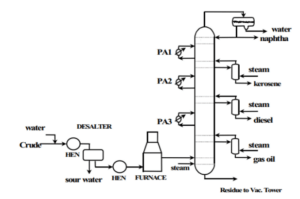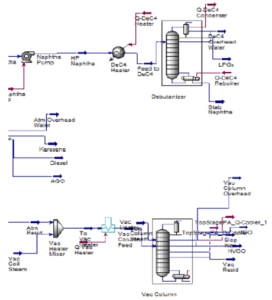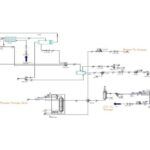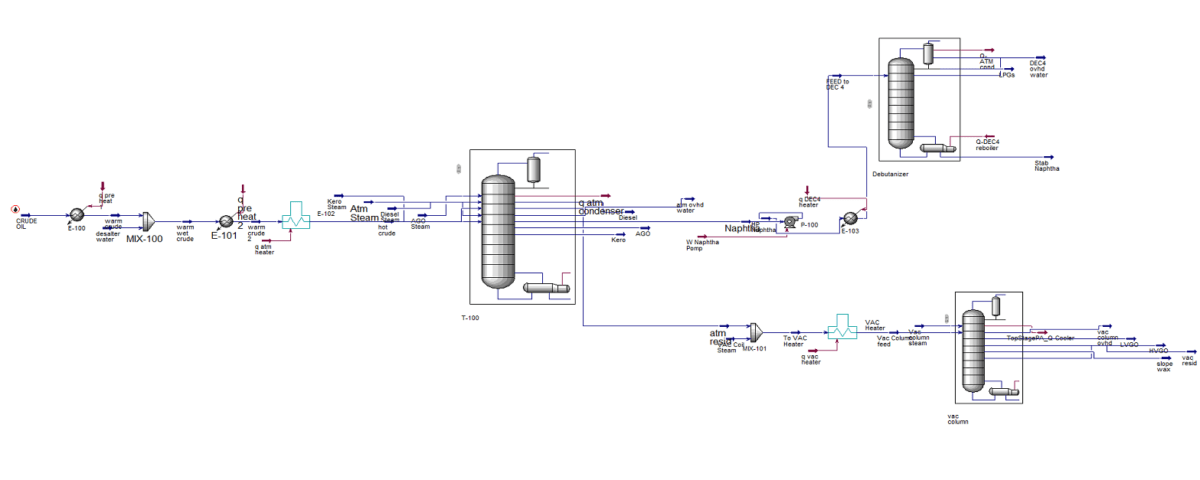Introduction
There is a rapid growth in the use and demand of crude oil in various industrial fields. Therefore, gasoline prices are rising due to higher than expected demand for petroleum products. Today, simulation has become an important tool in studying the behavior of almost all chemical processes. A proper modeling can bring great benefits to an industry, including increasing knowledge about the process without having to perform the actual processes. A good model is essential to develop an appropriate control strategy for a Crude Distillation Unit (CDU) because it can provide a more accurate study of the behavior of the actual system.
Process Description of Crude Oil Distillation Unit (CDU)
The figure below shows a typical diagram of a crude distillation unit, CDU. Crude oil is heated inside the unit using other streams. During heating, it is pumped and desalinated. The main heating process takes place in a furnace, the unit itself consists of an atmospheric distillation tower and three side bars. CDU operates in multiple cuts to distill crude oil. These cuts include naphtha, kerosene, light gas oil, heavy oil diesel and atmospheric residue. As these streams and surrounding atmospheric towers cool, they provide external heating to the crude oil. In addition, there is a drum return and recycle stream that contains an overhead gas producer gas and naphtha suitable for the catalytic reforming unit.

The operation of the vacuum tower stabilization process (VDU)
Vacuum towers are much larger in diameter than atmospheric towers, typically 12 to 15 meters. Operating pressure is maintained using steam ejectors and condensers. The size and number of vacuum devices is determined by the vacuum required and the quality of the vapors used, for 25 mm Hg usually three ejector stages are required. Reducing the pressure drop between the vacuum inducing device and the flash zone by a few millimeters saves operating costs. In standard actual refinery operation, the offered vacuum distillation capacity is 80,000 barrels per day (about 4 million tons per year) with a fuel consumption of about 3,200 MMBtu per day.
The main VDU feed is mainly crude distillation unit (CDU) residues. The top crude oil from the bottom of the CDU is pumped into the vacuum column after being heated by a furnace. Heavy vacuum gas oil (HVGO) and light vacuum gas oil (LVGO) are drawn from this 8-stage column. In the fire heater, there is a need to adjust the fuel flow to control the temperature. In the column (VDU), the pressure of the column should be controlled to avoid column breakage and cracking of the involved components.

Conclusion
In oil refineries, atmospheric and vacuum distillation units are important units in the production of crude oil products. Many of the oil cuts coming out of the vacuum tower do not match the market demand. Among these cases, it can be mentioned that the volume of light cuts is much less than the desired amount, while many heavy oil cuts are produced. The simulation of refinery processes, especially crude oil distillation, vacuum tower and stabilization using powerful software such as Span Hysys is considered a very valuable tool for chemical engineers and refineries. These simulations allow for more detailed investigation of the process, prediction of unit performance, optimization of operating conditions and evaluation of design changes.
Simulation of Crude Oil Distillation Unit (CDU), vacuum tower and stabilization with Aspen Hysys
In this project, the simulation of crude oil distillation unit (CDU), vacuum tower and stabilization is simulated with Aspen Hysys version 14 software. The project has a complete report (pdf file).


